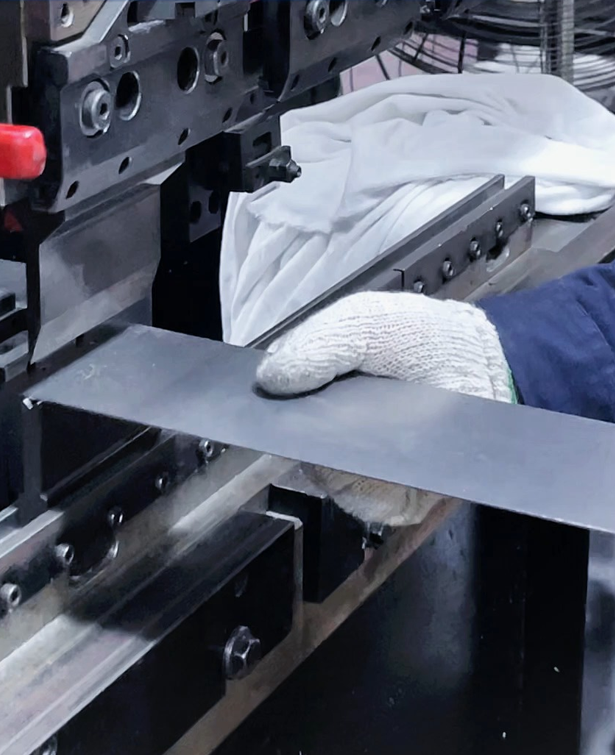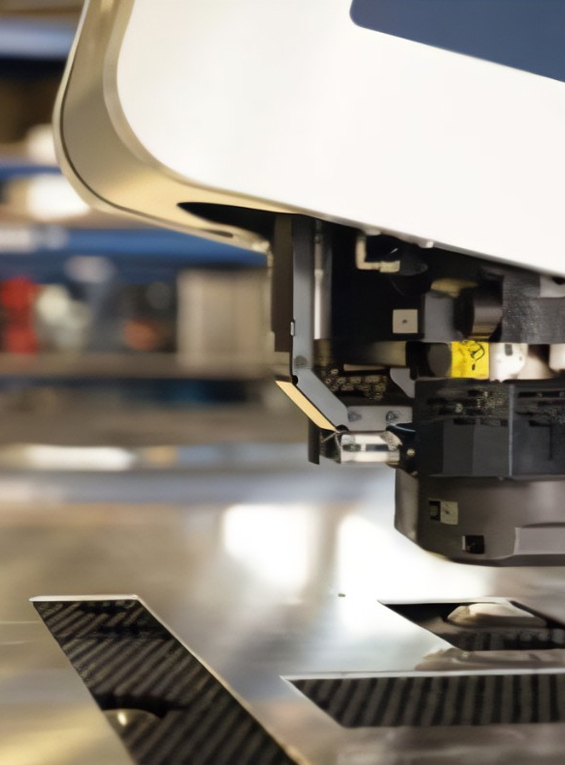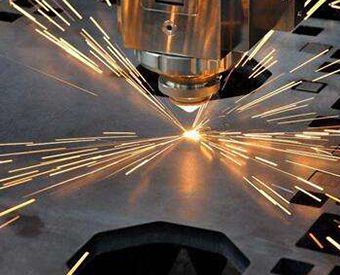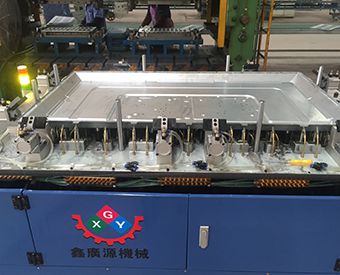
Quality Sheet Metal Service
Transform your ideas into reality with our industry-leading sheet metal fabrication services. At KeSu, we combine advanced technology, expert craftsmanship, and rapid turnaround to deliver high-quality, custom metal parts tailored to your exact specifications. Upload your design to get started and get an instant quote for custom sheet metal prototypes and production parts.
- Fast Turnaround
- Custom Surface Finishes
- Wide Range of Materials
- 200+ Experienced staff
What We Good At Sheet Metal Fabrication
Laser Cutting
Laser cutting is a subtractive manufacturing process that uses a high-powered and focused laser beam to create precise cuts in sheet metal materials. Laser cutting uses a focused laser beam to cut, etch, or engrave materials, vaporizing or melting them for precise edges and complex patterns based on designer specifications.
Bending
Welding
Welding is the process of joining two or more metal pieces using heat, pressure, or both to form a strong bond. It combines skill and precision to create durable, sturdy metal structures. Sheet metal assemblies involve joining multiple sheet metal components through a variety of processes, such as welding or riveting, to create an assembled final product.
Punching
Riveting
Stamping
Stamping uses dies and presses to shape flat metal sheets into different forms, creating complex, three-dimensional designs through cold-forming techniques. Our capabilities include computer-controlled manufacturing processes such as laser cutting, bending, punching, welding, stamping, and riveting.
From Design to Prototyping to Production
- 15+ Years of Experience
- ISO 9001:2015 certified QMS
- CMM Quality Inspections
- Surface Finishing Options

Custom Sheet Metal service
1
Rapid Prototyping
We offer high-quality rapid prototyping services in China, providing you with more competitive sheet metal prices and faster delivery times. We have developed the latest rapid prototyping technology to meet your design challenges, and will work with you to verify and improve your product sheet metal prototyping, conduct functional testing, and carry out engineering verification.
2
Rapid Manufacturing
KeSu is your best sheet metal manufacturing partner in China. We offer a range of solutions from effective rapid prototyping to production of sheet metal parts. Our sheet metal company's rich machining experience and ability to integrate resources enable us to meet the needs of any projects and ensure your parts always meet the highest quality standards.
3
Custom Sheet Metal
We provide one-stop rapid sheet metal services and cost-effective rapid custom sheet metal machining services. Do you need production-grade materials, complex geometric shapes, tight tolerances, or fine details? Working with the KeSu sheet metal factory, you can get sheet metal parts to the specs you require through the design prototyping and manufacturing process.
We've helped thousands of customers succeed

Thomas
Sales Manager

Addison.H
Head of Designer

Nancy. K
Engineer
He is my long term supplier with all my trust.
Can we please proceed the order for parts as quoted? Drawings and quote attached.
Sheet Metal Materials
| Material | Description |
|---|---|
| Aluminum |
Aluminium is lightweight, corrosion-resistant, and boasts an excellent strength-to-weight ratio, making it ideal for aerospace, automotive, and construction applications. Its machinability supports intricate designs, and it’s often used for enclosures, brackets, and panels. Available grades: Aluminum 1100-H14, Aluminum 5052-H32, Aluminum 6061. |
| Copper |
Copper is renowned for its excellent electrical and thermal conductivity, as well as high ductility. It’s a top choice for electrical wiring, plumbing, roofing, and heat exchangers, offering durability and formability for complex shapes. Available grades: Copper 101, Copper C110, Copper C110 H02, Copper 260 (Brass). |
| Bronze |
Available grades: Bronze 220, Bronze 510. |
| Stainless Steel |
Stainless Steel offers superior corrosion resistance, strength, and a polished appearance, ideal for medical devices, food processing equipment, and marine environments. Its ease of cleaning and durability make it a go-to for hygienic and high-wear applications. Available grades: Stainless Steel 301, Stainless Steel 304, Stainless Steel 304 #4 brushed, Stainless Steel 304 #8 mirror polish, Stainless Steel 316/316L, Stainless Steel 316 #4 brushed. |
| Steel |
Steel is exceptionally strong and durable, widely used in construction, heavy industry, and automotive applications. It can be alloyed for enhanced hardness or corrosion resistance, making it versatile for structural components, enclosures, and machinery parts. Available grades: Steel 1018 (Low Carbon), Steel 1045 (Hot Rolled), Steel A569/ASTM A1011 (Hot Rolled), AZ55 Galvalume, A653 Galvanized, 1095 Spring Steel, Steel A36, Steel A36 pickled and oiled, Steel A366/1008. |
| Nickel Alloys | Available grades: Inconel 625, Nickel Alloy 200, Nickel Alloy 400. |
| Titanium | Available grades: Titanium (Grade 2), Titanium 6AI-4V (Grade 5). |
| 姓名 | 描述 |
|---|---|
| 加工后 | 经数控机床加工后的表面光洁度为 Ra1.6,是一种经济高效的选择,但会留下刀痕。 |
| 阳极氧化 | II 型阳极氧化(黑色,光亮)可提高耐腐蚀性和耐磨性,同时允许进行染色,是铝制零件的理想选择。 |
| 抛光 | 抛光(Ra0.8,镜面抛光)可获得高光泽表面,减少表面粗糙度,增强金属的美观性。 |
| 喷砂 | 喷砂(#220)使用加压砂或其他介质来清洁和处理表面,从而形成均匀的哑光效果。 |
| 翻滚 | 滚筒抛光利用滚筒内的摩擦和磨损作用,使小零件变得光滑光亮,从而获得均匀但略带纹理的表面。 |
| 电抛光 | 电解抛光是一种化学工艺,可以使表面光滑亮泽,同时提高耐腐蚀性。 |
| 奥洛丁 | Alodine(化学薄膜:转化膜,黄色)涂层可提供防腐蚀保护并提高油漆附着力,主要用于铝表面。 |
| 热处理 | 真空热处理改变金属的机械性能,以提高其硬度、强度或延展性。 |
| 拉丝表面 | 拉丝(#220)表面处理可形成单向缎面质感,减少表面痕迹和划痕的可见性。 |
| 粉末涂装 | 粉末涂装可形成厚实耐磨的涂层,并具有优异的颜色和纹理选择,适用于各种表面。 |
| 电镀 | 电镀(镍,光面)将一层薄金属层附着在零件上,从而提高耐磨性、耐腐蚀性和表面导电性。 |
| 黑色氧化 | 黑色氧化是一种用于黑色金属的转化涂层,可提高耐腐蚀性并最大限度地减少光反射。 |
Sheet Metal FAQs
What is sheet metal fabrication?
Sheet metal fabrication is a manufacturing process that involves cutting, bending, forming, and assembling flat metal sheets into desired shapes and structures. It uses techniques like laser cutting, punching, bending, welding, and finishing to create parts for industries such as automotive, aerospace, and construction.
What materials are commonly used in sheet metal fabrication?
常用材料包括不锈钢(耐腐蚀)、铝(轻质、坚固)、低碳钢(价格实惠、坚固)、铜(导电)、黄铜和锌。板材厚度通常在 0.06 英寸到 0.25 英寸之间,较薄的板材延展性好,较厚的板材则适用于重型应用。
What are the main processes in sheet metal fabrication?
The primary processes are cutting (e.g., laser, plasma, waterjet, shearing), forming (e.g., bending, stamping, rolling), joining (e.g., welding, riveting, adhesives), and finishing (e.g., coating, polishing). Each process is chosen based on design requirements and material properties.
What surface finishes are available for sheet metal parts?
表面处理可以提升外观、耐用性和功能性。常见的表面处理方式包括:
- 机加工表面 (Ra1.6):直接从数控机床加工而来,具有经济实惠的表面光洁度,可见刀痕。
- II 型阳极氧化(黑色,光亮):提高耐腐蚀性和耐磨性,是铝材的理想选择,并可选择染色。
- 抛光(Ra0.8,镜面抛光):可获得高光泽、光滑的表面,增强金属的美感。
- 喷砂(#220):通过喷射介质清洁和处理表面,从而形成均匀的哑光质感。
- 滚筒抛光:通过在滚筒内摩擦来平滑和抛光小零件,从而获得均匀、略带纹理的表面。
- 电解抛光:通过化学方法使表面光滑亮泽,提高耐腐蚀性。
- 铝酸盐(黄色化学薄膜):提供防腐蚀保护并增强油漆在铝上的附着力。
- 拉丝表面(#220):形成单向缎面质感,最大限度地减少划痕的可见性。
- 粉末涂装:可形成厚实、耐用、耐磨的涂层,并提供多种颜色和纹理选择。
- 电镀(镍,光面):在材料表面镀上一层薄金属层,以提高耐磨性、耐腐蚀性和导电性。
- 黑色氧化:一种用于黑色金属的转化涂层,可增强耐腐蚀性并减少光反射。
How can I ensure precision in sheet metal fabrication?
Precision is achieved using high-precision equipment (e.g., CNC machines, laser cutters), skilled operators, and accurate engineering drawings. Maintaining proper tolerances (e.g., ±0.05 mm for tight precision) and consulting with fabricators during design ensure accuracy. Correct processing techniques, like overbending to account for springback, also help.
How can I control costs in sheet metal fabrication?
Control costs by selecting cost-effective materials (e.g., mild steel over aluminum), optimizing designs for manufacturability (e.g., uniform thickness, avoiding tight tolerances unless necessary), using efficient processes (e.g., laser cutting for precision), minimizing waste, and improving production efficiency to reduce defects. Outsourcing to specialized fabricators can also lower costs by avoiding in-house equipment investments.
What are the advantages of sheet metal fabrication?
Advantages include high precision, cost-effectiveness for prototypes and production, durability of parts, scalability from prototyping to large-scale runs, and versatility in creating complex shapes. It’s also compatible with a wide range of materials and finishes for functional and aesthetic purposes.
Sheet Metal Fabricating



Quote Now to Start Your Sheet Metal Fabricating Project
Complete Sheet Metal Fabricating services from prototype to production ensure high quality, fast delivery and competitive prices.